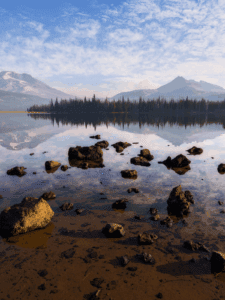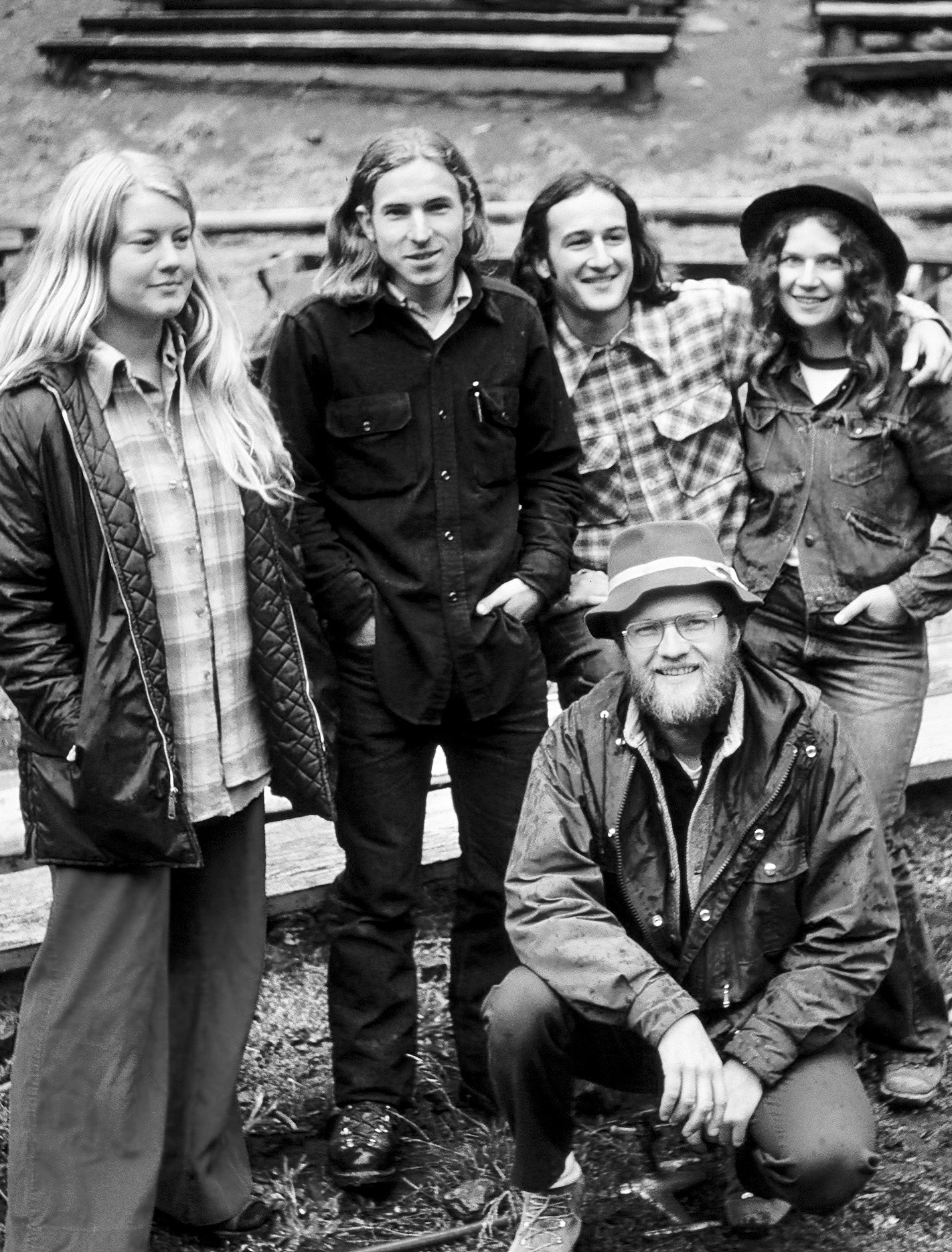
Who We Are
Our History
Since our official founding in 1974, Oregon Wild has been at the center of every major public lands and wildlife conservation battle in the state.
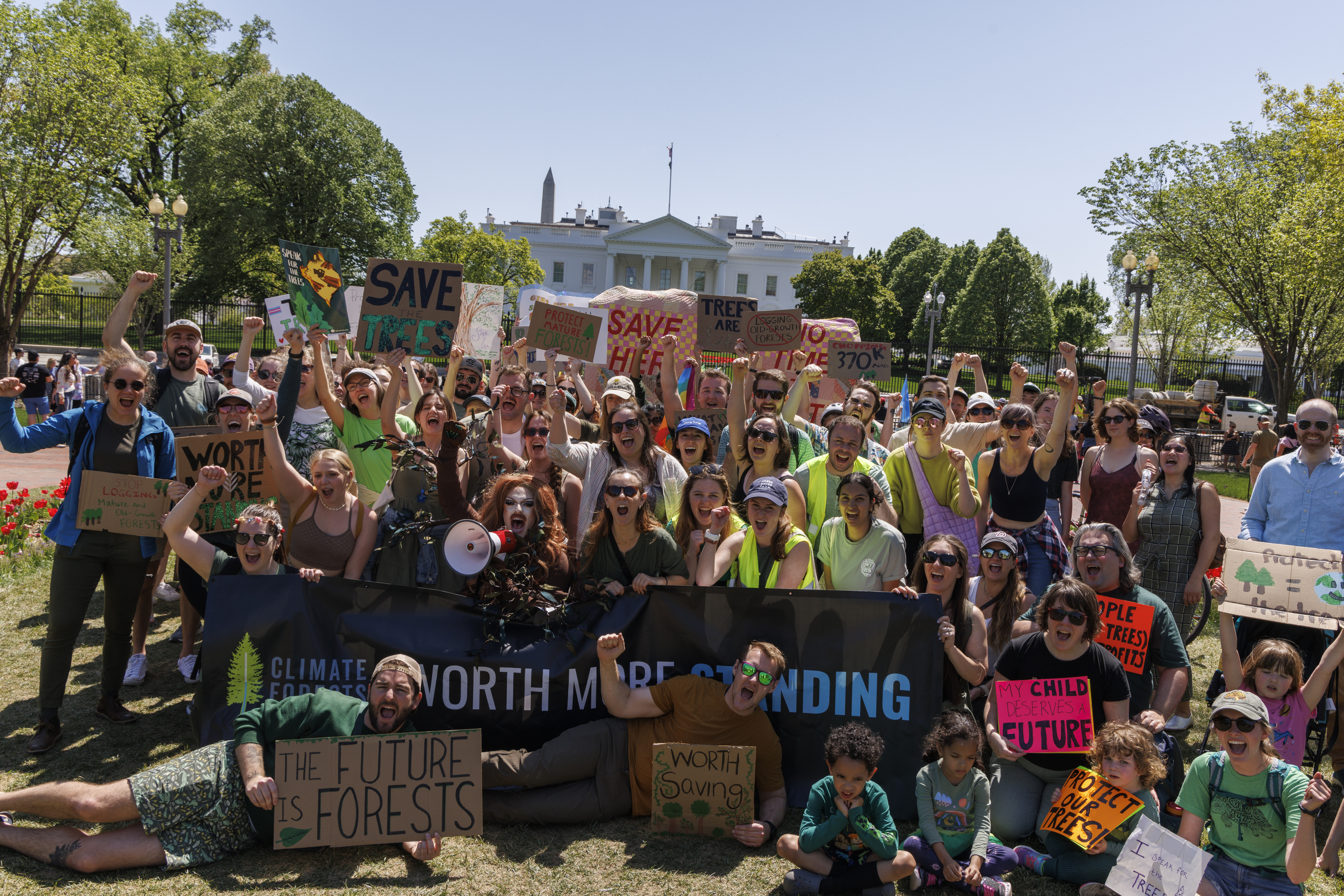
When land managers tried to avoid Wilderness protections, when the last old growth was on the chopping block, when wolves needed a voice in the halls of power—Oregon Wild was there. We’ve persevered to achieve the unlikeliest of successes for nature and kept the fire inside to learn from the stinging losses to emerge stronger. We’re proud of our history and know that there is much left to do to keep Oregon wild.
From a campfire to Congress
Oregon Wild filed articles of incorporation in 1974 with the goal of addressing specific wilderness issues in Oregon that were overlooked by the larger, national organizations at the time. This was the era when America’s bedrock environmental laws hit the books (the Wilderness Act in 1964, Wild & Scenic Rivers Act in 1968, National Environmental Policy Act in 1970, Endangered Species Act in 1973). But it would take grassroots organizations to breathe life into these laws and stand up for the local environmental values that mattered to Oregonians. This is how the Oregon Wilderness Coalition (our first name!) was founded.
-
 1972
1972A Movement is Born
National environmental groups carried the weight for the conservation movement in the early 1970s, but often left local activists feeling out of the loop. In Eugene, two staffers of the national groups – Bob Wazeka of the Sierra Club and Joe Walicki of the Wilderness Society – teamed up with local activist (and University of Oregon librarian), Holway “Holly” Jones, to organize the small grassroots groups that were springing up across Oregon into a formal coalition. The name “Oregon Wild Lands Coalition” was first used in 1972 (by Holly Jones at a RARE I hearing in Roseburg) and the Oregon Wilderness Coalition would be officially incorporated two years later.
-
 1973
1973Gathering around the campfire
In the fall of 1973 at Whitebranch Camp in the Willamette National Forest, Wazeka, Walicki, and Jones are joined by 10 groups and their members for the first ever Oregon Wilderness Conference. Those present commit to forming a coalition that will one day become Oregon Wild. The Conference becomes an annual staple – a date circled on the calendar for a generation of wildland activists to gather for community, inspiration, and to hold decision makers accountable. Notable attendees over the years include Senator Mark Hatfield, multiple future Governors, and rabble-rousers like Dave Foreman.
-
 1978
1978First major success, the Endangered American Wilderness Act
The Oregon Wilderness Coalition got its first big taste of victory in early 1978 when Jimmy Carter signed the Endangered American Wilderness Act. Oregon received an outsized share of the bounty, with 275,000 acres protected, including the first ever BLM Wilderness (the Wild Rogue) and official designation of French Pete as Wilderness after a decades-long fight to stop logging in the ancient forest gem. The bill was proof that grassroots organizers from all across the state, advocating for the place they knew and loved best, could convince Congress to forever protect special landscapes. As our first and longest serving Executive Director, James Monteith, wrote in the February 1978 newsletter: “This is a landmark bill for all conservationists and others who understand and value the great natural treasures of Oregon.”
Big protections and brewing peril
The eighties saw the young organization come into its own as a force for permanently protecting Oregon’s last wild places while facing the epidemic of ancient forest logging ravaging the state. As the decade wore on, it became clear that a previously little known bird – the northern spotted owl – was primed to force a reckoning in Pacific Northwest forests. Through tumultuous years, the organization took on a new name and grew in size and stature, accomplishing victories that would have seemed unlikely just a decade before.
-
 1982
1982Name change launches ONRC era
In recognition that the organization was branching out into more than just Wilderness advocacy and was creating its own identity as a force for nature beyond being a coalition of smaller entities, the board of directors voted to change the name to Oregon Natural Resources Council (ONRC). ONRC became a touchstone of the western conservation movement. Future generations of environmental law students would read about cases of precedential litigation bearing the “ONRC v.” title. In the same board meeting where the name change became official, a new Board President – a young biology teacher named Wendell Wood – was elected. Wendell soon became a staff member, working across four decades to defend Oregon’s special places, and – upon his untimely death in 2015 – was called the “conscience of the environmental community in Oregon.”
-
 1984
1984Breaking the logjam, the Oregon Forest Wilderness Act becomes law
After years of local advocacy for several million acres of proposed Wilderness all across the state, a breakthrough arrived in June 1984. As activists worked to convince and cajole members of the Oregon Congressional delegation to protect as much as possible, competing bills emerged from powerful senior Senator Mark Hatfield and conservation champion Congressman Jim Weaver. In the meantime, ONRC filed suit challenging the Forest Service’s RARE II process where only 262,000 acres of wilderness-quality land was identified by the agency. Delay in passing a Wilderness bill would put the other 3 million-plus acres of reviewed roadless lands under direct threat from logging. The threat of litigation lit a fire under Congress, and over 850,000 acres of Wilderness were protected in the Oregon Forest Wilderness Act. A major win in the bill came from the advocacy of ONRC’s Eastern Oregon Field Coordinator, Tim Lillebo, who (legend has it) used some creative crayon lines on a map to boost protections for the beloved North Fork John Day Wilderness to over 120,000 acres.
-
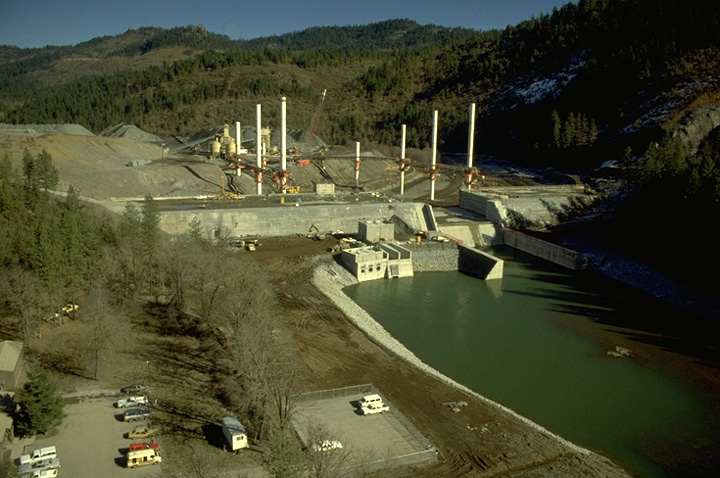 1985
1985Elk Creek Dam Campaign Launched
With the help of attorney Neil Kagan, Oregon Wild launched a 25 year campaign to notch Elk Creek Dam, and safeguard a key salmon and steelhead spawning tributary of the upper Rogue River. Historically, 30% of all the wild coho salmon in the Rogue Basin spawned in Elk Creek, and the 1300 acres of public lands the dam would have flooded provided vital calving and wintering areas for elk and other wildlife. In 2009, thanks to years of hard work by staff and activists from a range of organizations, as well as the leadership of former US Representative Peter DeFazio, we celebrated the partial demolition of the dam and return to a free-flowing river. Salmon advocates finished the job in 2019, when Elk Creek was designated a protected Wild and Scenic River.
-
 1988
1988220 timber sales appealed in a single month
After filing the first ever timber sale appeal referencing the spotted owl in 1981, ONRC brought the tactic to a whole new level seven years later. When the Forest Service gave the public only 30 days to respond to hundreds of zombie old-growth logging projects (many in areas that were still covered in snow), ONRC determined the only way to protect the public’s interest was to appeal them all. Describing the work in our Spring 1988 newsletter as a “dirty job but someone has to do it,” ONRC took the brunt of Congressional attacks but kept building momentum for protecting ancient forests.
-
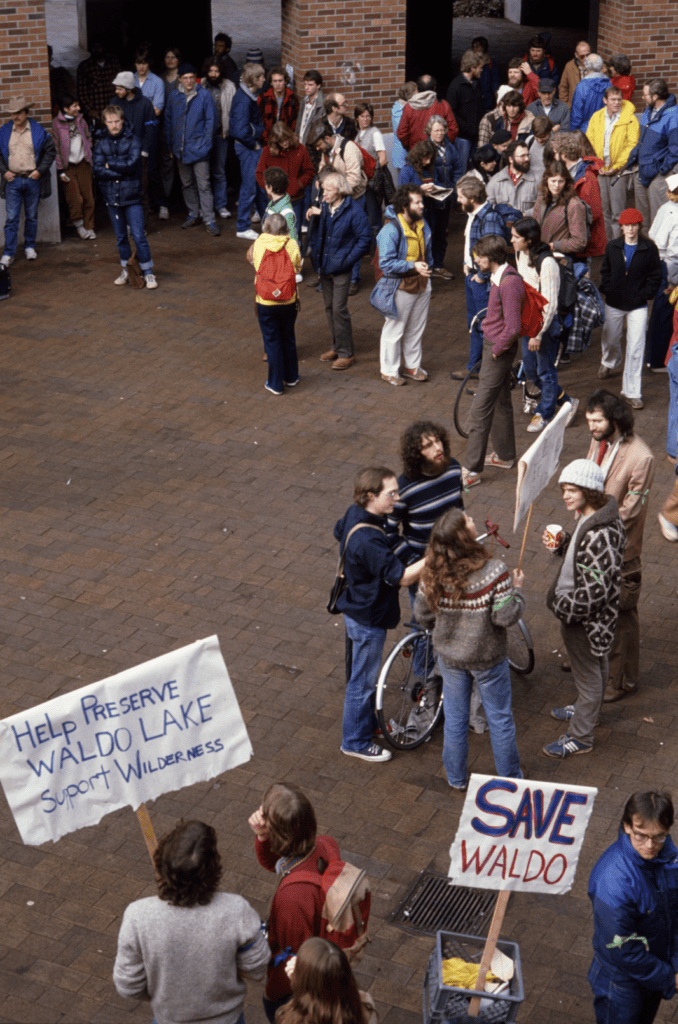 1988
1988Rivers run wild, Oregon Rivers Initiative and Oregon Omnibus Wild & Scenic Rivers Act become law
Dual efforts at the state and federal levels in 1988 cemented Oregon’s reputation as the Wild & Scenic River capital of the world. With acute threats from proposed dam-building and ongoing impacts to river-dependent species, a coalition led by ONRC (and former Rivers Coordinator Nancy Duhnkrack) pushed through a massive expansion of protected rivers across a two month span. First, in October, Congress passed the Oregon Omnibus Wild & Scenic Rivers Act, protecting 1,400 miles on 40 stream segments. Then, a month later in a new tactic for Oregon conservationists, voters approved (by a margin of 56% to 44%) a ballot measure to safeguard stretches of 11 waterways as State Scenic Waterways. Success at the ballot proved vital – as a State Scenic Waterway designation for a stretch of the Klamath River ultimately foiled the construction of the Salt Caves Dam.
Rising to save old growth
Decades of inaction from federal land managers reached a boiling point in the early 1990s as Pacific Northwest ancient forests became a national issue. In June 1990, the northern spotted owl made the cover of Time magazine. Inside the issue, a pugnacious Andy Kerr, ONRC’s longtime Conservation Director, was featured and described as “the Ralph Nader of the old-growth preservation movement.” As the profile of the “timber wars” grew, ONRC grew to meet the challenge – adding staff and relocating headquarters to Portland. By mid-decade, our 20-year fight for ancient forests culminated in a signature victory in the history of Oregon’s conservation movement.
-
 1990
1990“The great leap forward”
Recognizing the importance of the moment, the ONRC board approved a new strategy in 1988 to seize the momentum of the ancient forest issue, calling it the “great leap forward.” To be closer to the center of Oregon’s political power brokers, the organization’s headquarters were moved to Portland (ultimately culminating with the purchase of our Greeley office home in 1995, where we have been ever since!). To professionalize our team, we added our first official Development Director, Sally Cross, and hired the person who would become our longest serving Finance and Administration Director, Candice Guth. Under their fundraising and budget leadership, ONRC grew its membership to heights unseen before (over 6,000 members in the mid-’90s) with an accompanying growth in staff that allowed for the launch of desert, land use, and coastal conservation initiatives.
-
 1994
1994The Northwest Forest Plan era begins
The 1992 presidential contest saw the ancient forest issue and the fate of the spotted owl become a prime issue in the campaign. Following the Endangered Species Act listing of the spotted owl, ONRC and allies filed suit and Judge William Dwyer issued an injunction that effectively shut down old growth logging on 17 national forests in the Pacific Northwest. Then-candidate Clinton promised action if he won, and in April 1993 Clinton, Gore, and half the cabinet came to Portland to hear from all sides on the issue while 70,000 people rallied on Waterfront Park for ancient forest protections. The product of the summit was the Northwest Forest Plan (specifically, Option 9), an ecosystem based approach to managing forests in the range of the spotted owl. Though it reduced logging by 80%, ONRC and our allies were concerned that the new plan still allowed for logging of a dwindling supply of old growth forests that the spotted owl and countless other species needed for survival. Judge Dwyer ultimately ruled that the new plan was the “bare minimum” necessary to stave off extinction and the Northwest Forest Plan era began.
-
 1996
1996Logging Without Laws
The ink on the Northwest Forest Plan was barely dry when Congress (at the urging of timber-industry backed politicians in Oregon and Washington) passed a budget bill with the “Salvage Rider” attached. The rider suspended all environmental laws for federal lands logging, even allowing timber sales that ONRC had previously halted in the courts to proceed. The blatant disregard for the law prompted us to launch a new affiliated 501(c)(4) and Political Action Committees to ensure that politicians were listening to what Oregonians wanted. As ONRC took off the gloves and ramped up our public pressure on the Oregon delegation, lawless old growth logging prompted a convulsion of protest in the forest. Hundreds of activists were arrested attempting to stop chainsaws and bulldozers from entering ancient forests. The giants at Warner Creek were spared after a year-long blockade prevented access to the forest. Other groves were not as lucky. Over 28,000 acres of ancient forests were logged under the Salvage Rider in the last real bender of old-growth logging on Oregon’s federal public lands.
-
 1996
1996Portland’s drinking water saved with Bull Run legislation
Portlanders have relied on the Bull Run watershed for drinking water since 1895, and for much of that time the watershed was protected from human entry. But when the forest was opened up to clearcut logging from 1977 to 1993, 350 miles of logging roads began pouring sediment into the drinking water reservoirs. ONRC sprung into action, hiring Regna Merritt to work with community partners to protest harmful logging projects and ultimately spearhead federal legislation included in the Oregon Resource Conservation Act to permanently protect the Bull Run from logging and other harmful activities. Regna would go on to lead a 20-year career at ONRC, including 10 as Executive Director.
Coming of age in the new century
With a hard-earned reputation as a scrappy, state-based organization with a knack for pushing policy of national significance, ONRC entered the 21st century poised for big accomplishments and a final evolution of our public-facing identity. The new millennium promised to move Oregon’s politics and economy further away from timber dominance, but eight years of the George W. Bush administration threatened backsliding for forests and endangered wildlife.
-
 2001
2001Roadless Rule protects heritage forests
Since our inception, we have fought to keep wild places wild. Our first organizing efforts in the 1970s trained volunteers to respond to the Forest Service’s failure to accurately inventory roadless areas across the landscape they managed. Nearly three decades later, we helped to lead a national movement to provide stronger administrative protections for unroaded lands all across the country. Responding to over one million comments in favor (the most ever for a federal rulemaking at the time) President Clinton’s Forest Service enacted the Roadless Area Conservation Rule safeguarding 58 million acres across the country and 2 million acres here in Oregon.
-
 2006
2006Name change to Oregon Wild
What started as the Oregon Wilderness Coalition and became the Oregon Natural Resources Council (ONRC) adopted its forever name in 2006 – officially becoming Oregon Wild. For too long, members of the public assumed we were a chapter of NRDC, a government agency overseeing natural resource management, or – worse yet – a blandly named outfit actually advocating for the destruction of natural resources! The name change made it clear what the now 30-year-old organization stood for – keeping Oregon wild. In adopting the new name, we came full circle to the coalition moniker that our co-founder, Holly Jones, uttered in Roseburg in 1973 when he referred to the burgeoning group as the Oregon Wild Lands Coalition. Though the name and logo were new, at our core, we were the same tenacious group as always.
-
 2007
2007Defending backyard forests
Across much of the American West, BLM lands are known for beautiful desert vistas and critical sagebrush habitat, but in Oregon, BLM lands known as the O&C Forestlands became headline news at the tail end of the Bush administration. Interspersed in a checkerboard fashion with private lands throughout western Oregon, these important low-elevation forests linked together habitat in the Coast and Cascade Ranges, forming a vital piece of the reserve system of the Northwest Forest Plan. In a sweetheart settlement with the timber industry, Bush’s corrupt Department of Interior officials agreed to craft a new logging plan across 2.5 million acres that would triple ancient forest logging levels. As we’d done each time our forests were threatened before, Oregon Wild rose to the challenge to halt the Western Oregon Plan Revisions (derisively nicknamed the WOPR). After years of court battles, Oregon Wild and allies prevailed, only to see a watered down version of the same plan approved during the Obama administration – proving that the politics of forest destruction are sadly non-partisan.
Of wolves and wilderness
The return of a keystone species reminds us that wilderness is only truly wild when the top carnivores are present. As we expand a wildlife program and make major headway on long-sought Wilderness protections, we embrace rewilding as a central theme of our work. Inspired by the central tenets of conservation biology, we recommit to protecting cores habitat areas (Wilderness and roadless); corridors for species (intact forest ecosystems, wetlands, and waterways); and carnivores (species like wolves, sea otters, wolverines, and others that shape ecosystems through their behavior).
-
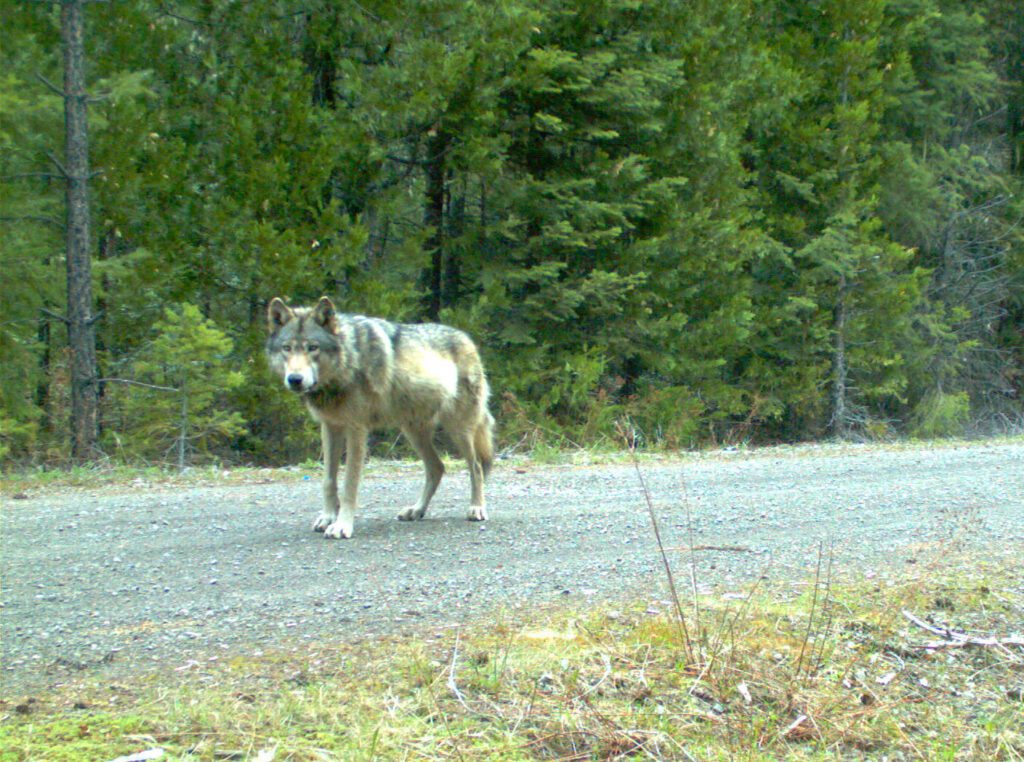 2008
2008Wolves return to Oregon launching wildlife program
After a 50 year absence brought on by state-sponsored eradication in the early 20th century, wolves return to Oregon with the first pups born in the state since before 1947. Recognizing that wolves needed a local voice with wildlife managers more accustomed to issuing hunting and fishing tags than protecting threatened species, Oregon Wild stepped in to lead wolf advocacy in the state. With allies, we negotiated improved standards for the wolf management plan, deemphasizing killing wolves in response to livestock depredation and promoting coexistence. Our exposure to state wildlife policies prompted our launch of an official Wildlife Program. While we continued our fight for the habitat imperiled species need to survive, we would also now work to ensure that agency management was responsive to their needs.
-
 2009
2009Largest expansion of Wilderness since 1984
After a decade-long campaign led by Oregon Wild, Congress enacts the Omnibus Public Lands Management Act. The bill includes Wilderness expansion in almost every corner of the state – 125,000 acres around Mount Hood and the Columbia River Gorge, desert Wilderness outside of Bend in the Badlands, coastal ancient forest in the Copper Salmon Wilderness, and a Wilderness core for the Cascade Siskiyou National Monument with the designation of the Soda Mountain Wilderness. With over 200,000 acres protected, the effort is the largest expansion of Wilderness since the heyday of the 1984 bill and proves once again that grassroots organizing for well-loved places across the state (coupled with a charismatic engine like Mount Hood) can propel Congress to act. Celebrating the victory was Wilderness Program Manager, Erik Fernandez, whose first tasks as an Oregon Wild volunteer back in 1999 were to map out the roadless areas that would form the backbone of the campaign.
-
 2019
2019Devil’s Staircase defies the odds
“Endless pressure, endlessly applied” took on new meaning when Devil’s Staircase was protected with a Wilderness designation in the middle of the otherwise anti-environment Trump presidency. Located deep in the heart of the Oregon Coast Range, Devil’s Staircase had been one of the last roadless areas left out of the 1984 bill. Local activists convinced Rep. Peter DeFazio that this special place – with its towering ancient trees and mythical stair-step waterfall – was worthy of consideration once again. Oregon Wild campaigned for a decade, narrowly missing passage multiple times before the Oregon Wildlands Act moved through Congress as part of a larger package and was ultimately signed into law by Trump. The Molalla River and over 250 miles of tributaries to the Rogue River were also designated as Wild & Scenic as part of the new law – proof that Oregon Wild’s dogged determination across decades pays off in a protected natural heritage.
Building on a legacy of protection
Passing our 50 year anniversary, Oregon Wild is taking on our biggest conservation campaigns yet. We’re leading a national effort to finally secure protection for all mature and old-growth forests on public lands for the vital role they play in fighting climate change. We’re leading a local coalition to enact Oregon’s single largest public lands protection effort in history, aiming to secure Wild & Scenic River designations for over 3,000 miles of waterways across the state. And we are dedicating ourselves to diversifying the Oregon conservation movement with our Public Lands For All initiative to ensure that everyone who loves and benefits from Oregon’s wild places has a voice in how they are protected.
